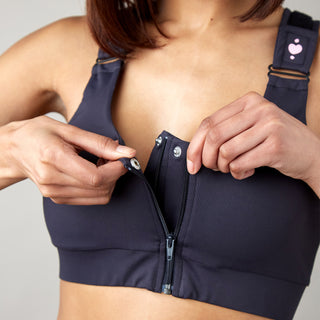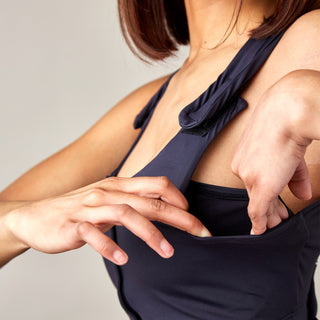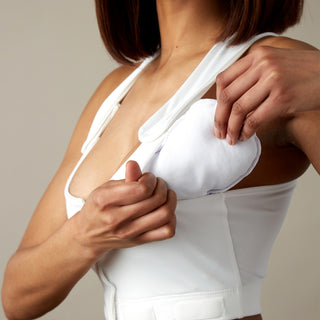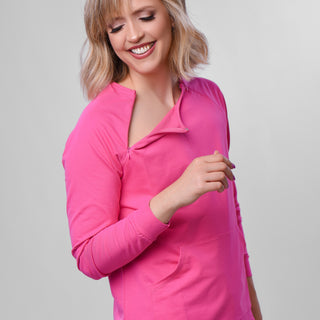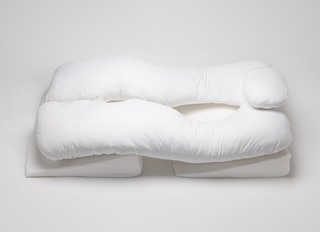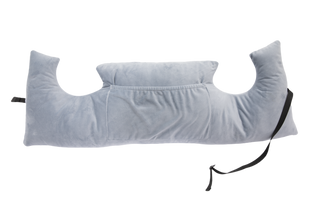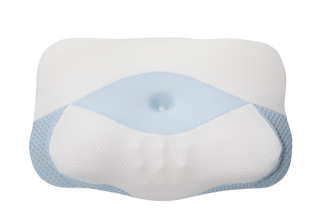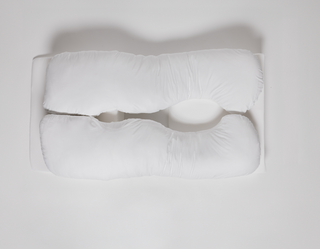With bras, as we age, what used to be a simple morning routine has become a frustrating puzzle. Your fingers don't quite cooperate the way they once did, reaching behind your back sends shooting pain through your shoulder, and those tiny clasps might as well be microscopic. You've already spent too many minutes wrestling with a bra that seems determined to defeat you before you've even had your coffee.
If this sounds familiar, you're not alone. Millions of seniors face this exact struggle every single day—a struggle that steals both time and dignity from what should be a straightforward part of getting dressed. And if you're an adult child watching a parent struggle with this daily challenge, you know the delicate balance between wanting to help and respecting their need for independence in such personal matters.
Here's the truth that nobody talks about: traditional bras weren't designed for the realities of aging bodies. They assume flexibility that arthritis has stolen, dexterity that stroke or neurological conditions have compromised, and shoulder mobility that years of living have gradually reduced. It's not that you've suddenly lost the ability to dress yourself—it's that the clothing industry forgot to evolve alongside our natural aging process.
But here's the good news: front closure bras for seniors with limited mobility aren't just "easier bras." They're independence in fabric form. They're dignity preserved. They're the difference between asking for help with intimate tasks and maintaining autonomy over your own body. And they're far more sophisticated than you might imagine.
This guide cuts through the confusion to help you understand exactly what makes front closure bras different, which features actually matter for limited mobility, and how to find options that work with your specific challenges—not against them.
Understanding the Real Challenge: Why Traditional Bras Stop Working
Let's be honest about what's really happening. For decades, you've been reaching behind your back, manipulating tiny clasps, and twisting your arms into positions that defy basic anatomy. You managed because your body was flexible, your hands were nimble, and your shoulders moved freely through their full range of motion.
Then life happened. Maybe it was gradual—arthritis creeping into your fingers, shoulders that grew stiffer with each passing year, hands that just don't grip quite as firmly. Or perhaps it was sudden—a stroke that affected one side of your body, shoulder surgery that permanently changed your mobility, or a condition like Parkinson's that makes fine motor control unpredictable.
Whatever the cause, the result is the same: traditional back-closure bras have become daily obstacles rather than simple garments.
The Biomechanics Working Against You
Traditional bras require a complex series of movements that challenge multiple body systems simultaneously:
Shoulder Rotation and Flexibility: Reaching behind your back requires significant shoulder flexibility—specifically, the ability to internally rotate your shoulders while extending your arms backward. This movement becomes increasingly difficult with rotator cuff issues, frozen shoulder, arthritis, or simply the natural loss of flexibility that comes with aging.
Fine Motor Control: Those tiny clasps demand precision that arthritic fingers, tremor-affected hands, or neuropathy-compromised nerves struggle to provide. What once took seconds now takes minutes of careful manipulation.
Hand Strength and Grip: Fastening clasps requires grip strength that many seniors have lost due to arthritis, weakness from stroke, or general aging. The frustration of knowing exactly what you need to do but physically being unable to execute it is profound.
Bilateral Coordination: Traditional bras require both hands to work together in a coordinated dance—one hand holding, the other clasping. For stroke survivors or anyone with unilateral weakness, this coordination is impossible.
Sustained Awkward Positions: Even if you can reach, maintaining that position long enough to manipulate clasps can be painful or exhausting. Holding your arms in uncomfortable positions strains muscles and joints that may already be compromised.
The Dignity Factor Nobody Mentions
Beyond the physical challenges lies something equally important: the emotional toll of losing independence in such an intimate area. Having to ask a spouse, adult child, or caregiver for help with your bra isn't just inconvenient—it's a loss of privacy and autonomy that affects self-worth and confidence.
Many seniors simply stop wearing bras altogether rather than face the daily struggle or ask for help. But going without proper support brings its own problems: discomfort, poor posture, self-consciousness, and sometimes even back pain.
Front closure bras for seniors with limited mobility solve both the physical challenge and preserve the dignity that matters so deeply.
 The Front Closure Advantage: More Than Just Convenience
The Front Closure Advantage: More Than Just Convenience
Front closure bras aren't simply traditional bras turned around. They're fundamentally redesigned garments that work with aging bodies rather than against them. Understanding these differences helps you appreciate why they're genuine solutions, not just marketing gimmicks.
Biomechanical Simplicity and Reduced Strain
Front closures eliminate behind-the-back reaching, twisting, and contortions entirely. Every movement happens where you can see it, where your shoulders move most naturally, and where your hands have their strongest grip and finest control. Your arms stay in comfortable positions throughout—no sustained awkward poses that strain already-compromised joints and muscles.
For anyone with compromised dexterity, this visual feedback becomes crucial. You watch your fingers work, make adjustments as needed, and know immediately whether you've secured the closure. This eliminates the anxious uncertainty of wondering whether you've actually fastened the bra properly while simultaneously reducing physical strain on shoulders, back, and hands. It's the difference between attempting surgery while blindfolded versus performing it under bright lights with full visibility.
One-Handed Operation Possibilities
Many front closure designs can be managed with a single hand if necessary—crucial for stroke survivors or anyone with unilateral weakness. While traditional bras absolutely require both hands working together, front closures offer the possibility of true one-handed dressing with practice.
Maintained Support Without Compromise
The common misconception is that front closure bras sacrifice support for convenience. Quality front closure bras for seniors with limited mobility provide excellent support through thoughtful engineering—wide bands, strategic seaming, and proper construction that doesn't rely on back closures for structural integrity.
SHOP THE BEST FRONT CLOSURE BRA FOR SENIORS
Essential Features That Actually Matter for Limited Mobility
Not all front closure bras are created equal, and when you're dealing with limited mobility, specific features make the difference between a bra that solves your problems and one that creates new frustrations.
Closure Types: Choosing What Works for Your Hands
The front closure mechanism itself varies significantly between styles, and different types work better for different mobility challenges:
Velcro Closures: Medical-grade Velcro provides secure fastening with minimal fine motor control required. Simply press the two sides together and they stick—no precise alignment needed. For severely arthritic hands or anyone with tremors, Velcro offers the easiest operation. Quality Velcro closures are designed to maintain their grip through hundreds of openings and closings without losing effectiveness.
Zipper Closures: Front zippers can be easier than traditional clasps, especially when they feature large zipper pulls that arthritic fingers can easily grasp. Some seniors find zippers more intuitive than other closure types, particularly if arthritis affects their ability to pinch or press. Look for zippers with substantial pulls—small zipper tabs defeat the purpose.
Wide, Cushioned Straps That Don't Dig In
Traditional bra straps concentrate pressure on small areas of your shoulders. When you're older, skin becomes more delicate and susceptible to irritation. Wide, cushioned straps distribute weight across a larger surface area, preventing the painful digging and marking that narrow straps cause.
For seniors, strap width isn't just about comfort—it's about preventing actual skin damage. Look for straps at least 1 inch wide, preferably with soft padding on the underside that contacts your skin.
Adjustability Without Complexity
Your body changes—sometimes daily due to swelling, water retention, or simply the natural fluctuations that come with aging. Adjustable features let you modify fit without needing a completely new bra.
However, adjustability must be truly accessible. Complicated adjustment systems with multiple sliding pieces or tiny mechanisms defeat the purpose. Look for:
-
Simple slide adjusters that move easily without requiring tight pinching
-
Medical-grade Velcro straps that can be repositioned quickly
-
Easy-grip tabs for any adjustment mechanisms
-
Limited adjustment points to keep things simple
Look for designs where adjustability truly serves your needs rather than adding unnecessary complexity.
Seamless or Strategically Seamed Construction
Aging skin becomes more sensitive and prone to irritation. Traditional bras often have seams in problematic locations that rub, chafe, or create pressure points on delicate skin.
Quality front closure bras for seniors feature either seamless construction or seams placed strategically away from sensitive areas. Look particularly for:
-
No seams across the nipple area
-
Smooth, flat seams that don't create ridges
-
Tag-free design that eliminates a common irritation source
-
Soft inner fabric that feels gentle against your skin
Fabric That Works With Aging Skin
The fabric blend in your bra directly impacts daily comfort, especially as skin becomes more sensitive with age:
Moisture-Wicking Properties: Many seniors deal with increased perspiration due to medications, hormonal changes, or decreased temperature regulation. Moisture-wicking fabrics actively pull moisture away from your skin, keeping you dry and preventing the rashes and irritation that dampness can cause.
Breathability: Proper air circulation prevents overheating and reduces moisture buildup. Quality fabrics balance support with breathability, ensuring you stay comfortable throughout the day.
Softness Without Compromise: The fabric must be soft enough for sensitive skin while still providing adequate support. High-quality blends achieve this balance through careful engineering rather than choosing one over the other.
Hypoallergenic Materials: Aging skin often becomes more reactive to synthetic materials and treatments. Look for hypoallergenic fabrics that minimize the risk of allergic reactions or sensitivity issues.
Temperature Regulation: Many seniors struggle with temperature control due to hormonal changes, medications, or simply the body's changing ability to regulate heat. Quality fabrics help manage this challenge through breathability and moisture-wicking properties that prevent overheating while keeping you comfortable. This is particularly important for those experiencing hot flashes or taking medications that increase perspiration.
Support That Doesn't Require Underwires
Traditional underwires can become painful pressure points, especially for seniors with sensitive ribcages or those who've lost padding due to weight changes. Quality front closure bras provide support through construction techniques rather than relying on potentially painful underwires:
-
Wide elastic bands beneath the bust that distribute support
-
Shaping without wires - Simplified sizing and shaping from the band creates a custom fit closure
-
Multi-panel design that offers support through seaming
-
Strategic compression that lifts gently without pressure points
Coverage That Provides Security
Many seniors prefer more coverage than typical contemporary bras offer. Higher necklines and fuller coverage provide:
-
Better temperature regulation by covering more skin
-
Reduced self-consciousness about aging breast tissue
-
Protection for sensitive skin areas
-
More surface area for support distribution
Look for styles that offer full coverage without feeling frumpy or dated. Modern design proves you can have both modesty and contemporary styling.

heart&core: Front Closure Bras for Seniors with Limited Mobility
At heart&core, bra design meets genuine understanding. Our approach to front closure bras addresses the specific challenges seniors face:
Accessible Closures: Medical-grade Velcro closures on both the front and straps eliminate the need for fine motor control while maintaining secure fastening. The soft Velcro won't scratch sensitive skin but provides reliable hold through daily wear and repeated washing.
Intelligent Support Structure: Wide, cushioned straps distribute weight to prevent digging and discomfort on delicate skin. The racerback design prevents the common frustration of straps sliding off shoulders—especially important when wearing bras for extended periods or when shoulder strength is limited.
Thoughtful Construction: Seamless design eliminates irritation points, while the wide elastic band beneath the bust provides support without the pressure points that underwires create. Built-in pockets accommodate breast forms or cooling inserts if needed.
Real-World Durability: Fabrics that withstand frequent washing while maintaining compression and shape—critical when you're wearing these bras daily and need them to last.
Comprehensive Support: Beyond just selling bras, heart&core provides detailed sizing guides, measurement instructions, and fitting support to help you find the right option even when in-person fitting isn't practical.
Most importantly, heart&core's designs work for multiple needs—whether you're managing arthritis, recovering from surgery, or simply dealing with the natural mobility changes that come with aging. Their front closure bras serve as true adaptive solutions rather than temporary workarounds.
Making an Informed Choice
When evaluating any front closure bra:
-
Confirm the closure type works for your specific dexterity limitations
-
Verify adjustability is genuinely accessible, not just technically present
-
Check that materials are appropriate for sensitive, aging skin
-
Ensure the company understands mobility challenges, not just fashion trends
-
Read reviews from other seniors or people with similar mobility limitations
Quality front closure bras represent an investment in your independence and daily comfort. Choose options designed by companies that understand what you're actually dealing with—not just what looks good in marketing materials.
SHOP THE BEST FRONT CLOSURE BRA FOR SENIORS

Finding Your Perfect Fit When Trying On Is Complicated
Traditional bra fitting advice assumes you can easily try on multiple options, twist and turn in front of mirrors, and accurately assess fit while wearing the bra. For seniors with limited mobility, this process needs adaptation.
Measuring for Success
Accurate measurements become even more important when mobility issues make extensive try-on sessions impractical:
Band Measurement: Measure around your ribcage directly under your bust, keeping the tape measure level all the way around. If reaching around yourself is difficult, have someone help or measure in sections—front measurement plus back measurement.
Bust Measurement: Measure around the fullest part of your bust, typically across your nipples. Again, if reaching is challenging, measure in sections and add them together.
Consider Changes: Your pre-mobility-limitation bra size may not be your current size. Bodies change with age, medications can cause swelling, and weight distribution often shifts. Measure fresh rather than assuming your historical size still applies.
Fit Indicators You Can Check Yourself
When trying on front closure bras, assess these fit elements:
Band Comfort: The band should feel snug but not tight. You should be able to slide two fingers under the band comfortably. If you're between sizes, size up—comfort matters more than technical fit precision at this stage of life.
Strap Pressure: Straps should rest on your shoulders without cutting in. If you see red marks or indentations after wearing, either the straps need adjustment or you need a different size.
Closure Ease: You should be able to fasten and unfasten the front closure without struggle. If it takes significant effort or multiple attempts, that closure type may not suit your specific dexterity limitations.
No Riding Up: The band should stay in place throughout the day. Constant readjustment defeats the independence purpose.
Movement Freedom: You should be able to reach forward, lift your arms moderately, and move through your typical daily activities without the bra shifting or becoming uncomfortable.
When Ordering Online Makes Sense
For many seniors with mobility limitations, getting to stores is challenging. Online ordering offers convenience but requires careful approach:
-
Study size charts carefully: Each brand sizes differently, so don't assume your size
-
Read return policies first: Ensure you can return items if the fit isn't right
-
Start with one: Before ordering multiple styles, test one to understand the brand's fit
-
Look for detailed product photos: Close-ups of closures help you understand if you can operate them
FIND YOUR SIZE FOR FRONT CLOSURE BRAS
Special Considerations for Specific Conditions
Different mobility limitations require different considerations when selecting front closure bras.
Arthritis: When Fingers Don't Cooperate
Arthritis affects hands in ways that make different closure types more or less manageable:
For Severe Arthritis: Velcro closures work best, as they require minimal fine motor control and no pinching or squeezing.
For Moderate Arthritis: Velcro closures or easy-grip zippers may work well, especially on days when arthritis is less active.
Stroke Recovery: Working With One Side
Stroke survivors often face the unique challenge of having one fully functional side and one weaker side.
One-Handed Operation: Choose closures you can definitively operate with your stronger hand. Practice the technique while seated with the bra in your lap before attempting to wear it.
Weighted Hems: Some adaptive clothing companies offer weighted hem options that help keep fabric in place while you manipulate closures one-handed.
Strategic Positioning: Learn to use your body and furniture to help hold fabric in place—resting one side against your body while working the closure with your functional hand.
Shoulder Limitations: Frozen Shoulder, Rotator Cuff Issues
Shoulder problems create specific challenges.
Step-In Styles: Look for front closure bras that open completely so you can step into them rather than pulling them over your head or sliding arms through straps.
Wide Armholes: Ensure armholes are cut generously enough that limited shoulder mobility doesn't prevent getting your arms through.
Front-Adjustable Straps: If you can't reach your shoulders to adjust straps, look for styles where strap adjustments are accessible from the front.
Parkinson's and Tremor-Related Conditions
Tremors create frustration with closures requiring precision:
Velcro Closures: Bigger target areas accommodate less precise hand movements.
Avoid Small Components: Tiny hooks, loops, or buttons will create unnecessary frustration.
General Aging and Reduced Flexibility
Even without diagnosed conditions, natural aging reduces flexibility and dexterity:
Prioritize Simplicity: Don't overcomplicate things with features you don't need. Basic, well-designed front closure bras with simple closures serve you better than feature-loaded options that add complexity.
Consider Help Frequency: If you only need assistance occasionally (like when arthritis flares), a slightly more complex closure you can usually manage yourself makes sense. If you need help daily anyway, optimize for comfort over independence-focused features.
Vision Impairment and Low Vision Challenges
Many seniors face vision challenges that make traditional bra fastening even more difficult:
The Front Closure Advantage for Limited Vision: When you can't see what your hands are doing behind your back, fastening becomes nearly impossible. Front closures bring everything into your visual field—or at least into a position where you can feel what you're doing more effectively.
Tactile Guidance: Even with limited vision, front closures allow you to use tactile feedback effectively. You can feel the closure mechanism, guide pieces together, and confirm proper fastening—all without needing to see perfectly.
Beyond the Bra: Making the Entire Dressing Process Easier
Front closure bras solve one significant challenge, but a holistic approach to dressing makes your entire routine smoother.
Adaptive Dressing Techniques
Occupational therapists recommend specific techniques that reduce strain:
Sit While Dressing: Dressing while seated improves balance, reduces fall risk, and makes the process less tiring.
Work From Bottom Up: Put on underwear and pants first, then your bra, then top layers. This sequence requires less complicated movements than other orders.
Use Your Environment: Rest arms on furniture, use walls for balance, and let surfaces help hold fabric in place while you work with closures.
Dressing Aids and Tools
Simple tools can make front closure bras even easier:
Long-Handled Shoehorns: Help slide straps up arms when shoulder mobility is limited.
These tools aren't admissions of defeat—they're practical solutions that smart people use to maintain independence.
Timing Matters
Choose when you dress strategically:
Morning vs. Evening: If arthritis is worse in the morning, lay out clothes the night before and dress after pain medication has taken effect.
After Movement: Gentle stretching or movement before dressing can improve flexibility and make the process easier.
When You're Not Rushed: Don't try to dress quickly when you're stressed or hurried. Give yourself time to work through the process calmly.
Real Life: Making Front Closure Bras Work in Your Daily Routine
Let's talk about the practical realities of incorporating front closure bras into your actual life.
How Many Do You Need?
Most seniors benefit from having at least three front closure bras in rotation:
-
One to wear: Your current bra
-
One in the wash: Because daily wearing means daily washing for many people
-
One backup: For when the first two are in rotation or when something needs repair
Having multiple bras isn't frivolous—it's practical planning that ensures you're never without appropriate support.
Caring for Your Bras to Extend Their Life
Proper care helps your bras maintain their support and ease of use:
Hand Washing: Gentlest on fabrics and closures. Use mild soap and lukewarm water.
Machine Washing: If hand washing is too difficult, use a lingerie bag and gentle cycle. This protects closures from damage and prevents straps from tangling.
Air Drying: Never put bras in the dryer. Heat destroys elastic and damages closures. Lay flat or hang to dry.
Gentle Handling: Velcro should be fastened before washing to prevent it from catching on fabric. Zippers should be closed.
Inspection: Regularly check that closures still function properly. Velcro that's losing its grip or zippers that are sticking should prompt replacement before the bra becomes difficult to use.
Wardrobe Integration
Front closure bras work with virtually any wardrobe, though some considerations help:
Higher Necklines: Many front closure designs have slightly higher necklines than traditional bras. Choose tops that complement this rather than trying to wear low-cut styles that reveal the bra.
Layering: Simple camisoles or layering tanks can provide additional coverage if desired and work well with front closure styles.
Color Selection: While white and nude are standard, some brands offer colors. Choose colors that won't show through your most frequently worn clothing.
When to Replace
Even quality bras eventually need replacement:
-
Elastic loses recovery: When the band no longer snaps back to original shape
-
Closures wear out: Velcro loses grip or zippers stick
-
Fabric thins or tears: Natural wear makes the bra less supportive
-
Fit changes: Your body changes, and your bra should accommodate those changes
Plan to evaluate your front closure bras every 6-12 months and replace as needed. This isn't wasteful—it's maintaining the tools that support your independence.
What Not to Settle For
Understanding what constitutes a quality front closure bra helps you avoid wasting money on inadequate options.
Don't Accept "Close Enough"
Insist on bras specifically designed for limited mobility, not just sports bras with front zippers marketed toward seniors. True front closure bras for limited mobility incorporate thoughtful design elements that generic options miss.
Avoid These Red Flags
Closures That Require Strength: If you can barely open or close the fastening, it's wrong for your needs. Move on.
Cheap Materials: Fabric that feels rough, thin, or scratchy won't improve with wearing. Quality materials are essential for all-day comfort on sensitive skin.
Inadequate Adjustability: If you can't modify fit as your body changes throughout the day or over time, the bra won't serve you long-term.
Complicated Instructions: If the bra comes with extensive instructions for how to put it on, it's probably too complicated for daily use with limited mobility.
Poor Reviews About Durability: Check what other seniors say about how long closures remain functional. Velcro that fails after a month or magnets that pop loose aren't acceptable.
Companies That Don't Understand Post-Surgical and Mobility Needs
Some companies truly understand the specialized needs of people requiring adaptive clothing, while others simply add "adaptive" labels to standard products. Seek out companies with authentic understanding of mobility challenges—their products work better because they're solving problems they genuinely comprehend rather than following market trends.
FAQ: Your Questions About Front Closure Bras for Seniors with Limited Mobility
How do I know if I really need a front closure bra, or if I should just keep trying with regular bras?
If you're asking this question, you probably already know the answer. Traditional bras that cause daily frustration, pain during fastening, or require help from others signal it's time to switch. Front closure bras aren't admitting defeat—they're choosing practical solutions that preserve your independence and dignity.
Will a front closure bra provide adequate support, or am I sacrificing support for convenience?
Quality front closure bras provide excellent support through thoughtful engineering—wide bands, strategic construction, and proper sizing. You're not sacrificing support; you're gaining a bra designed to provide support in a way your body can actually use.
Can I sleep in a front closure bra?
Many front closure bras are comfortable enough for sleeping, especially if you prefer the support or have medical reasons to wear a bra overnight. Choose styles without rigid structures and with very soft fabrics for overnight wear.
How many front closure bras do I need?
Three is ideal—one to wear, one in the wash, and one backup. This rotation ensures you always have a clean, functional bra available without needing to wash and dry one immediately to wear the next day.
Will insurance cover front closure bras for limited mobility?
Coverage varies significantly between insurance providers and plans. If your mobility limitation is related to a medical condition or post-surgical recovery, your doctor may be able to write a prescription that makes the bras eligible for coverage under durable medical equipment (DME).
Even without insurance coverage, many find front closure bras worth the investment for the independence and comfort they provide. Many are eligible for purchase using HSA (Health Savings Account) or FSA (Flexible Spending Account) funds with proper documentation.
What if my mobility limitation is only on one side—will front closure bras still help?
Absolutely. Front closure bras are particularly helpful for unilateral limitations because you can operate the closure with your functional hand while using your body or furniture to help position the other side.
Can I put a front closure bra on by stepping into it instead of putting it over my head?
Many front closure styles open completely, allowing you to step into them or wrap them around your body. This eliminates the need for overhead arm movements that can be difficult with shoulder limitations.
How tight should a front closure bra feel?
Snug but comfortable. You should be able to slide two fingers under the band easily. At this life stage, comfort takes priority over technical fit perfection. If you're between sizes, size up rather than down.
What's the difference between a front closure bra and just turning a regular bra around?
Front closure bras are engineered with the closure in front, meaning proper support structure, strap placement, and weight distribution all account for front fastening. Turning a regular bra around puts closures in the right place but maintains the wrong support structure, resulting in poor fit and inadequate support.
Disclaimer
This article is intended for informational purposes only and should not be considered medical advice. While front closure bras can significantly improve quality of life for seniors with limited mobility, they are not medical devices and do not treat medical conditions. Always consult with your healthcare provider about mobility limitations and any medical conditions affecting your ability to dress independently.
Individual needs vary significantly based on specific mobility limitations, medical conditions, body type, and personal preferences. The features and recommendations discussed in this article are general guidelines. Specific product choices should be based on your individual situation and, when appropriate, recommendations from occupational therapists or other healthcare professionals familiar with your needs.
If you experience new or worsening mobility limitations, pain, or other symptoms, consult your healthcare provider promptly rather than relying solely on adaptive clothing solutions.


